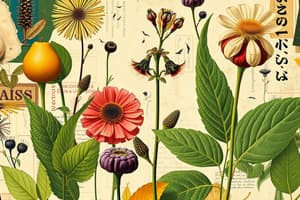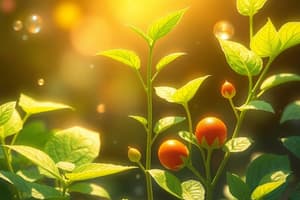Podcast
Questions and Answers
What is the main difference between autotrophs and heterotrophs?
What is the main difference between autotrophs and heterotrophs?
Autotrophs prepare their own food, while heterotrophs depend on other organisms for food.
Explain the process of photosynthesis in plants.
Explain the process of photosynthesis in plants.
Photosynthesis is the process where plants convert carbon dioxide and water into glucose using sunlight and chlorophyll.
What are the raw materials required for photosynthesis?
What are the raw materials required for photosynthesis?
Water, carbon dioxide, sunlight, and chlorophyll.
How do plants store glucose for future use?
How do plants store glucose for future use?
Why do plants need nitrogen for growth and development?
Why do plants need nitrogen for growth and development?
How do insectivorous plants like Venus Flytrap obtain nitrogen?
How do insectivorous plants like Venus Flytrap obtain nitrogen?
What is the reason plants cannot directly utilize nitrogen in the gaseous form?
What is the reason plants cannot directly utilize nitrogen in the gaseous form?
What is the mode of nutrition where organisms rely on other organisms for food?
What is the mode of nutrition where organisms rely on other organisms for food?
What is the term for a relationship where organisms benefit each other?
What is the term for a relationship where organisms benefit each other?
Which type of plants have rhizobium bacteria in root nodules to fix nitrogen for their own use?
Which type of plants have rhizobium bacteria in root nodules to fix nitrogen for their own use?
What is the mode of nutrition where organisms feed on dead and decaying matter?
What is the mode of nutrition where organisms feed on dead and decaying matter?
Give an example of a parasitic organism that depends entirely on another organism for nutrients.
Give an example of a parasitic organism that depends entirely on another organism for nutrients.
Flashcards are hidden until you start studying
Study Notes
- Aishwarya welcomes students to the Akash National Talent Hunt Exam.
- The exam is free for students in 7th to 12th grade.
- Registration for the exam is also free.
- The exam offers 100 scholarships, All India rank cash rewards, mock tests, and a NASA trip opportunity.
- The session transitions to a biology class on nutrition in plants.
- A strategy session will cover exam planning, time management, and motivation.
- Baiju's Mini Learning Program offers free access to the first thousand users weekly using a code.
- Nutrition in plants involves autotrophic and heterotrophic modes.
- Autotrophs prepare their own food using simple substances (e.g., green plants).
- Heterotrophs depend on other organisms for food (e.g., animals).
- Photosynthesis is the process where green plants convert carbon dioxide and water into glucose using sunlight and chlorophyll.
- Raw materials for photosynthesis include water, carbon dioxide, sunlight, and chlorophyll.
- Xylem transports water and minerals from roots to leaves, while phloem transports food materials.
- Glucose is stored in plants as starch for efficient storage.
- Plants require nitrogen along with other nutrients for growth and development.
- Nitrogen fixation by bacteria converts gaseous nitrogen into usable forms for plants.
- Insectivorous plants like Venus Flytrap obtain nitrogen by trapping insects and digesting them.
- Insectivorous plants can still perform photosynthesis even though they feed on insects.
- Plants cannot directly utilize nitrogen in the gaseous form due to its chemical stability.- Nitrogen is an inert gas and highly stable, making it unusable directly by plants due to lack of necessary chemicals for breakdown.
- Plants require nitrogen-fixing bacteria or separate nitrogen addition for utilization.
- Inert gas nitrogen does not chemically react with anything.
- Autotrophic mode of nutrition is where organisms produce their own food through processes like photosynthesis.
- Heterotrophic mode of nutrition involves organisms relying on other organisms for food, known as heterotrophs.
- Symbiosis is a relationship where organisms benefit each other, with lichens being a common example of algae and fungi working together.
- Leguminous plants have rhizobium bacteria in root nodules that fix nitrogen for the plant's use.
- Parasitic mode of nutrition involves one organism depending entirely on another for nutrients, without killing the host organism.
- Examples of parasitic organisms include Cuscuta and Rafflesia, which are dependent on host organisms for nutrition.
- Saprotrophic mode of nutrition is when organisms feed on dead and decaying matter, with fungi being a common example.
- Fungi form hyphae (thread-like structures), and a network of hyphae is called mycelium.
Studying That Suits You
Use AI to generate personalized quizzes and flashcards to suit your learning preferences.




